Yesterday’s live coverage of the Ukraine conflict can be found here. An archive of our liveblogs can be found here. For an overview and analysis of this developing story see our latest podcast.
Please help The Interpreter to continue providing this valuable information service by making a donation towards our costs.
For links to individual updates click on the timestamps.
For the latest summary of evidence surrounding the shooting down of flight MH17 see our separate article: Evidence Review: Who Shot Down MH17?
Ukrainian fire-fighters were able to beat back the forest fire near
the closed Chernobyl nuclear station, and say the flames are not in
danger of reaching the plant, Unian.net reported.
But Ukrainian Interior Minister Arsen Avakov reported on his Facebook page that the fires had stopped only five kilometers
away from the Chernobyl sarcophagus in which the radioactive remains
were buried, and authorities remain on high alert.
The Ukrainian Emergency Situation Commission sent in planes to douse the flames from the air.
Translation: putting out the Chernobyl forest fire.
Fire-fighters were able to beat back the forest fire near
the closed Chernobyl nuclear station, and say the flames are not in
danger of reaching the plant, Unian.net reported.
But Avakov he indicated that the fire could have been set deliberately (translation by The Interpreter). He gave two updates tonight, the second one more reassuring:
Update at 22:00//
At 18:30 the situation with the forest fire around the Chernobyl station has worsened. The flames once again attacked the forest in the direction of the Chernobyl nuclear power plant. The top flame and the severe gusts of wind created a serious threat of the fire spreading to the 20-kilometer zone near the Chernobyl plant. The fire zone is about 400 hectares of forest.The prime minister convened the Emergency Situations Commission (ESC). The National Guard and divisions of the Interior Ministry were put on alert. Yatsenyuk and officers of the ESC are working at the site directly near the line of fire attack. I’m in the operations headquarters in Kiev at the airport and coordinating the special [fire-fighting] aviation flights.
Update at 22:00
Arseniy Yatsenyuk already spoke at the briefing and you’ve seen the news on the wire services. Zoryan Shkiryak already gave a report on the details. But I’ll say in brief:
1. Once aggain by nightfall, they had beat back the top flames. That’s very good, by evening the wind died down and we’re localizing the situation quickly around the key loci.
2. A well-founded suspicion of deliberate arson has emerged. Since the foci are in several places along both sides of the river.
3. We’ve strengthened the patrols — the alarm has been raised and the National Guard and division of the Interior Ministry are on alert.
4. Why such worry? Because there has not been such a fire since 1992 – there is about 20 km to the station, but to the sarcophagus there is about five km. So they cut it off there first of all.
5. The radioactive background is normal.
6. The prognosis this time is good. BUT! It is too important and the risks great so as not to be sufficiently vigilant. Therefore we are at maximum attention. If there is news, I’l ltell you.
This time, there are no grounds for fright and panic. We have it under control.
At an emergency briefing this evening broadcast by 112 Ukraina, Nikolai
Chechetkin, deputy chair of State Emergency Situations made the same claim, Unian.net reported:
“The
nature of the fire speaks for itself, taking into account that there
exists at the present time certain foci, and new foci of the fire
emerge, the nature of this fire indicates that the likely preliminary
reason for the outbreak of such a fire was arson or careless handling of
fire.”
Translation: Chernobyl
Translation: Fire in Chernobyl. The forest is burning. 28.04.15.
— Catherine A. Fitzpatrick
The Ukrainian interior minister, Arsen Avakov, has written on his Facebook page that forest fires in the country’s north have deteriorated and is spreading towards the ruins of the Chernobyl nuclear power plant.
According to Avakov, gusts of wind have brought the fires within 20 km of the power plant. The area affected by the fires covers around 400 hectares of forest.
National Guard and Interior Ministry units are on alert while officers from the State Emergency Service are working on the scene.
Avakov writes (translated by The Interpreter):
We are working. We understand the responsibility and will not tolerate an underestimation of the risks!
The interior minister said that more information will follow at 20:30 (17:30 GMT).
— Pierre Vaux
The latest OSCE report (dated April 27 at 19:30 Kiev time) stresses something we reported earlier — armor and heavy artillery belonging to Russian-backed separatists is within the demarcation zone with increasing frequency, Ukraine is also using heavy artillery (Ukraine maintains they’re only returning fire) and the security situation near Donetsk is deteriorating:
The security situation in the area around Donetsk airport (“Donetsk People’s Republic” (“DPR”)-controlled, 11km north-west of Donetsk) has seriously deteriorated whereas in Luhansk region the SMM observed no incidents involving the use of weapons.
From the Joint Centre for Control and Co-ordination (JCCC) observation post at Donetsk railway station (“DPR”-controlled, 8km north-west of Donetsk), the SMM heard a total of 550 explosions from the north-east, north-north-east, north-west and west, at a distance of one to six kilometres from its position.
The SMM assessed that approximately 90% of all the explosions were caused by 120mm mortar and heavy artillery rounds. The number of violations in this area has increased sharply compared to the violations recorded in the previous days.
From a parking lot basement in the destroyed new terminal of the Donetsk airport, the SMM heard six explosions consistent with the sound of artillery or mortar shelling. The SMM saw one of them impacting 1,5km north of the airport runway and estimated it to be a 82mm mortar shell.
The SMM visited the office of the JCCC in government-controlled Avdiivka (15km north-west of Donetsk) and was informed by the Russian Armed Forces and Ukrainian Armed Forces representatives that there were 44 violations reported on 26 April between 15:00 and 21:00hrs in the area including the use of anti-aircraft guns and 120mm mortars. The interlocutors also reported 26 violations consisting of small arms fire, automatic grenade launcher a well as 82mm and 120mm mortars on 27 April until 12:00 hrs.
The OSCE also reports that armor belonging to Russian-backed fighters continues to be seen near the front lines northeast of Mariupol, where there is evidence that Ukrainian forces have fired on multiple positions:
The SMM visited for the first time the “DPR”-controlled villages of Dzerzhynske (25km east of Mariupol), Leninske (22km east of Mariupol), Oktyabr (26km north-east of Mariupol) and Zaichenko (24km north-east of Mariupol)*. In Dzerzhynske, the residents informed the SMM that one man was killed outside his house when a mortar shell hit the yard at around 16:00hrs on 26 April. The crater analysis on this site indicated that the mortar was fired from a westerly direction. The SMM observed further craters in the village, which, according to residents impacted on the same day. In Zaichenko, the SMM also saw “DPR” members exercising at a shooting range in the village as well as four Infantry Fighting Vehicles (BMP-1, BMP-2, BTR-70 and MTLB).
In Sakhanka (24km east of Mariupol, “DPR”-controlled) residents complained to the SMM about the intense shelling of the village. The inhabitant showed the SMM that several houses, the school and a kindergarten were severely damaged by mortar shelling, according to interlocutors on 25 April between 19:00 and 21:00hrs. The crater analysis performed by the SMM showed that the mortars were fired from a westerly direction.
In multiple areas, particularly near Donetsk and Shirokino, heavy weapons have been spotted well inside the demarcation line:
The SMM continued to observe the presence of military hardware close to the contact line. In Donetsk region, the SMM observed three MBT T-64 stationary in government- controlled areas and two T-64 in “DPR”-controlled Oktyabr (26km north-east of Mariupol). On 27 April the SMM Unmanned Aerial Vehicle (UAV) monitored the area around Shyrokyne, where it observed a number MBTs on both sides of the line of contact. In particular, the UAV observed four MBTs in the area of Bezimenne (“DPR”-controlled, 28km east of Mariupol), two MBTs in Lomakyne (government-controlled, 15km east of Mariupol), one MBT in Pavlopil (government-controlled, 27km north-east of Mariupol) and one MBT in Oktyabr. In government-controlled areas of Luhansk region, the SMM observed on 26 April four MBTs T-64 in (already reported, see SMM daily report 23 April)
Elsewhere, the OSCE has either witnessed compliance with the ceasefire agreement or has been able to negotiate settlements to potential problems:
The SMM went back to government-controlled Toshkivka (60km north-west of Luhansk) and observed newly constructed military fortifications (trenches, tank ditches) (see SMM daily report 25-26 April 2015, http://www.osce.org/ukraine-smm/153916).
There was no excavation in progress while the SMM was on the spot. The villagers complained to the SMM that the new fortifications are too close to the village. The SMM facilitated a temporary arrangement between the Ukrainian Armed Forces present and the villagers. According to this arrangement, the excavations would not continue and the demonstrators would agree to return to their homes and not invite the press until a lasting solution is found. The Ukrainian military personnel also agreed that they would check all fields in the area for mines.
The villagers dispersed shortly after this arrangement was reached.
On 26 April, the SMM spoke with the local Aidar volunteer battalion commander and six of his soldiers in government-controlled Trokhizbenka (33km north-west of Luhansk). The commander expressed concern about the 9 May celebrations where he fears that armed members of “Lugansk People’s Republic” (“LPR”) could be intoxicated. The SMM suggested arranging a meeting with its local counterpart on the “LPR” side prior to 9 May. The commander supported the idea.
The SMM returned to a heavy weapons holding site spotted on 24 April in “LPR”-controlled territory. On the site the SMM observed 18 main battle tanks (MBT) T-64 and one MBT T-72. All weapons complied with the withdrawal lines. The MBTs were in different stages of maintenance.
The SMM revisited one heavy weapons holding area of the Ukrainian Armed Forces and found all the items previously recorded to be in situ. The area holds 18 Uragan (BM-27) multiple launch rocket systems (MLRS). The SMM checked these weapons for the first time on 7 March (see SMM Daily Report 9 March 2015, http://www.osce.org/ukraine-smm/144336) and has visited the holding area several times since.
The SMM also checked a site where heavy weapons are being prepared for a “LPR” Victory day parade to be held on 9 May. The SMM recorded no changes in the numbers and type of heavy weapons reported after previous visits (see SMM daily report 23 April 2015, http://www.osce.org/ukraine-smm/153381).
The OSCE is also concerned about political rallies — both that activists may be targeted and that rallies may spark violence, especially during sensitive events like the May Day and Victory Day holidays:
In Kharkiv, the SMM enquired with regional representatives of the Ministry of Interior (MoI), the Security Service of Ukraine (SBU), the city council and political parties on the legal status of the rallies scheduled by activists during the upcoming May celebrations. Following an advice issued by the local SBU, the city council representatives said they would request from the Kharkiv administrative court the prohibition of all political rallies until 10 May.
According to MoI and SBU as well as city council officials, there were increased risks of terrorist attacks during this period. On 24 April, the court prohibited the regular Ukrainian Communist Party (UCP) march scheduled on 1 May. Representatives of the UCP said however that another meeting they planned on 28 April in front of the regional administration building has not been prohibited by the court.
On 26 April, the SMM observed the weekly speeches on Kulykove Pole square in Odessa and spoke with two activists from the Non-Governmental Organisation (NGO) Voice of Odessa (Golos Odessy). The head of the NGO stated that on 23 April her home had been searched for the third time by the SBU. She also stated that another member of the NGO had been detained by SBU around 24 April and severely beaten while in custody. This information was reportedly provided to her by the victim’s attorney. The information was subsequently corroborated to the SMM by a member of the UN Human Rights Mission in Ukraine (HRMU) who was present at the hearing on measures of restraint at Primorskyi district court, and observed contusions on the individual.
The SMM met with the recently re-elected head of Ivano-Frankivsk city court who informed the SMM that the city court was dealing with several cases of desertion some of which were at the trial phase, while others were concluded, with pronounced sentences.
In Kyiv region, the SMM attended an official opening of the first centre for the psychological and physical rehabilitation for “Anti-Terrorist Operation” (“ATO”) veterans in Ukraine. A representative from the Ukrainian Ministry of Defence emphasized that all Ukrainian servicepersons who returned from the “ATO” area would undergo counselling and testing.
— James Miller
Dajey Petros who blogs at Ukraine@War has highlighted photos taken yesterday by Alexander Ermochenko for the European Pressphoto Agency (EPA) showing 2S1 Gvozdika self-propelled guns on the streets of Donetsk.
Here are more of Ermochenko’s photos:
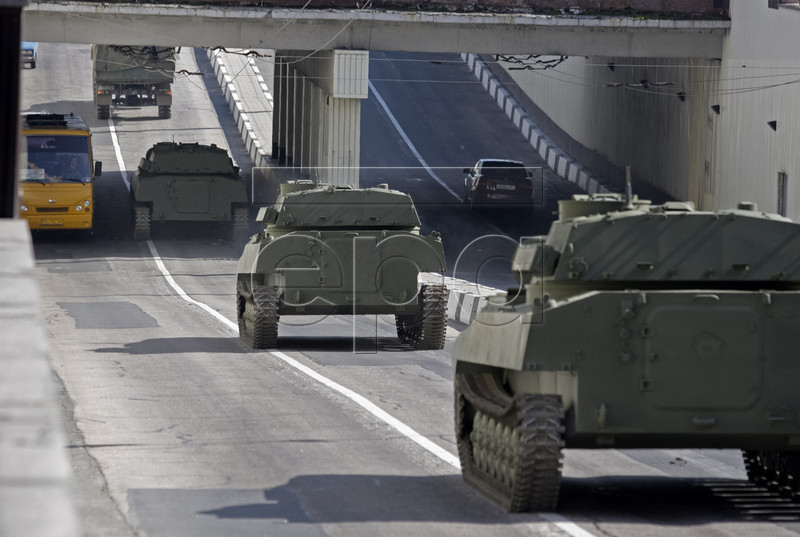
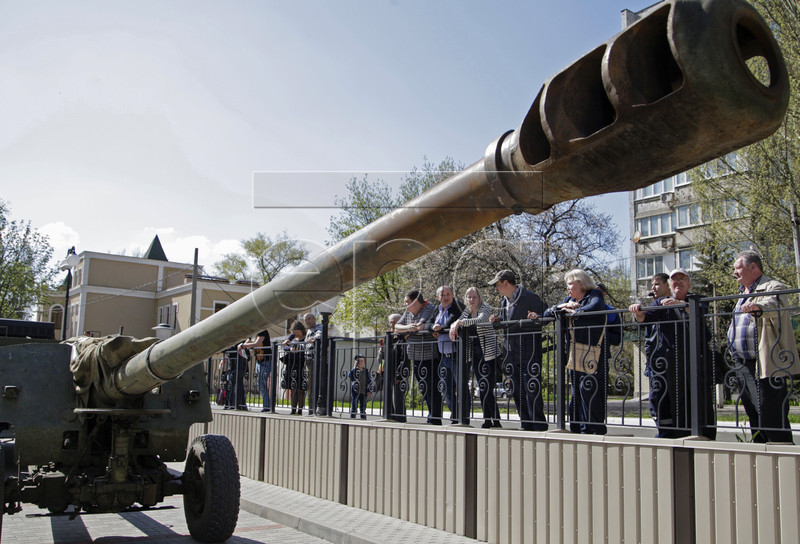
The 2S1 Gvozdikas are armed with 122 mm howitzers, weapons that, under the February Minsk agreement, should be withdrawn at least 50 km from the contact line with Ukrainian forces.
If we map out a 50 km radius from Donetsk, it becomes clear that the deployment of such weapons anywhere within the city of Donetsk is a violation of the Minsk agreement:

Blue markers on the map indicate Ukrainian-held settlements, red indicate separatist-held.
The EPA site notes that the self-propelled artillery are being moved as part of the preparations for the Victory Day parade due to be held in the separatist-held city on May 9.
The OSCE Special Monitoring Mission (SMM) to Ukraine has notified the Russian-backed separatists that the use of such heavy artillery in the Donetsk parade constitutes a violation of the Minsk agreement.
An SMM report from April 20 noted:
In his letter of 10 April to the signatories of the Minsk Package, the SMM Chief Monitor expressed his concern about reports that heavy weapons may be redeployed to proscribed areas for exercises or military parades. He reminded all sides that firing of any weapon, as well as deployment of any heavy weapon, in proscribed areas constitutes a violation of the Minsk agreements, and stated that the SMM will continue to report them as such.
— Pierre Vaux
Kristina Belousova, spokesperson for the Russian Federal Penitentiary Service (FSIN), has announced that Nadezhda Savchenko has been transferred to a civilian hospital in Moscow, confirming what her lawyer, Mark Feygin, told Interfax yesterday.
According to Belousova, Savchenko has been taken to the 20th city hospital for further observation. Doctors will work to establish further treatment methods. By the evening, she said, Savchenko had begun to eat again, having resumed her hunger strike for the last four days.
Yesterday, Savchenko’s health was reported to be failing by both Feygin and Mikhail Fedotov, the head of the Presidential Council on Human Rights.
Nadezhda Savchenko is a Ukrainian military officer and MP who was captured by separatist fighters in the Lugansk region and illegally transported to Russia, where she is on trial for the alleged murder of two Russian journalists.
— Pierre Vaux
Today at 5:21 on the Odessa Railroad, an explosion occurred during the movement of an electric freight car at the 25th kilometer mark between Kseniyev Station and Akardzha Station, the Interior Ministry Press Service reported.
There were no injuries as a result of the explosion. Fifty centimeters of railroad track are damaged and a pit with a diameter of 1.5 meter and depth of 80 cm has been formed.
“The Explosive Device Operation Plan was immediately put into action. An investigative operations group with the explosives service was immediately dispatched to the scene. All the circumstances are being determined,” said the notice.
The plan is regularly deployed by police in response to reports of explosions, dozens of which have plagued Ukrainian cities in recent months.
— Catherine A. Fitzpatrick
Oleksandr Motuzianyk, the Ukrainian Presidential Administration’s spokesman on the Ukrainian military’s Anti-Terrorism Operation, has announced that one Ukrainian soldier has been killed and 14 wounded over the last 24 hours, Interfax-Ukraine reports.
The ATO Press Centre claimed this morning that Russian-backed forces had conducted 22 attacks on Ukrainian positions between 18:00 and midnight yesterday, using both heavy artillery and Grad MLRS.
The Interpreter translates:
“In the Avdeyevka area, bandit groups opened fire on Anti-Terrorist Operation forces with BM-21 Grad rockets, while from 21:00 to 21:01, they launched a salvo of Grads at the village of Novolapsa in the Volnovakha district.”
The attack on Novolapsa is interesting as the OSCE reported on Sunday that a large accumulation of armoured vehicles had been recorded in separatist-held territory in this approximate area.
Granitnoye, to the south, has been a regular target of attacks since the first Minsk agreement in September, but the build-up of force and the use of such heavy weaponry (the use of which has become significantly rarer since the February Minsk agreement) suggest the potential for a move on Ukrainian forces in Volnovakha, to the west, and a pincer attack on Mariupol.
Meanwhile the pro-separatist Donetsk News Agency (DAN) reports that Sergei Ivanov, head of the administration of the separatist-held Telmanovo district, east of Novolapsa and Granitnoye, that three residential buildings in the village of Novaya Maryevka had been damaged by Ukrainian shelling.
DAN also reported that the mayor of the village of Donetsk-Severny, in the Yasynovataya district, north-west of Donetsk, claimed today that Ukrainian forces had shelled his village, injuring a 68-year-old man.
The ATO report goes on to say that Ukrainian positions near Opytnoye, Avdeyevka, Chermalyk, Peski and Schastye were attacked with 120 mm mortars, while heavy artillery was also directed at positions near the first three.
Novosti Donbassa reports that the governor of the Lugansk region, Hennadiy Moskal, claimed today that the attack on Schastye was conducted from the separatist-held village of Vsyolaya Gora with automatic grenade launchers.
A total of 25 rounds were fired, the governor said, towards a Ukrainian checkpoint near a bus station and bridge on the town’s south-eastern fringe.
As has been reportedly on an almost daily basis in recent weeks, there were, the governor said, skirmishes on the outskirts of both Krymskoye and Troitskoye.
Censor.NET reports that the Ukrainian State Border Guard Service announced today that 5 mortar shells had been fired at a checkpoint manned by both border guards and Ukrainian army soldiers in Zolotoye, north-east of Troitskoye.
The Border Guard Service reported no casualties.
In addition, the report claimed that 26 drone flights had been detected over the Donetsk and Lugansk regions over the last 24 hours.
— Pierre Vaux
An extremely powerful explosion occurred this morning in a Russian military camp, in the Rostov region, near the village of Kuzminka, around 70 kilometres from the Ukrainian border.

Photo – Dmitry Tokarev
The Russian Emergencies Ministry has declared a state of emergency in the area and has evacuated residents from the villages of Golovinka, Priyut and Chkalov, a total of around 800 people, TASS reports.
According to the state-owned news agency, a spokesman for the Emergencies Ministry’s regional department for prevention and relief said that the state of emergency affected the entire Sovietinskoye rural settlement, a municipal area of the Neklinovsky district.
A military spokesman said that the cause of the explosion was a fire on-board a self-propelled artillery system.
The Interpreter translates:
As Igor Gorbul, chief of the press office for the Southern Military District, said earlier, at around 7:45 Moscow time a fire broke out inside a self-propelled artillery system due to a short circuit as vehicles from one of the Southern Military Districts units departed their field camp for planned combat exercises.
As a result of the fire, the launchers on-board ammunition detonated.
The Russian military routinely refers to deployments into Ukrainian territory as “planned combat exercises.” Using the phrase to describe both the circumstances of deaths and the grounds for troops to be transferred to the Rostov region.
Dmitry Kuznetsov, chief doctor at the Neklinovsky District Central Hospital, told DonNews.ru that six wounded people had been brought into his hospital.
Most of the casualties had suffered burns but Kuznetsov said that there were no severe injuries. However RBC.ru reported that two of the wounded soldiers had suffered contusions and another had had a hand blown off.
According to DonNews, the first blast was followed by a fire at an ammunition dump. Eyewitness reported that the blasts could be heard dozens of kilometres away from the camp.

Translation: Taganrog, April 28, view towards Kuzminka

The vast military camp at which the blast occurred, situated near the villages of Kuzminka and Golovinka, was first reported on in Janurary this year.
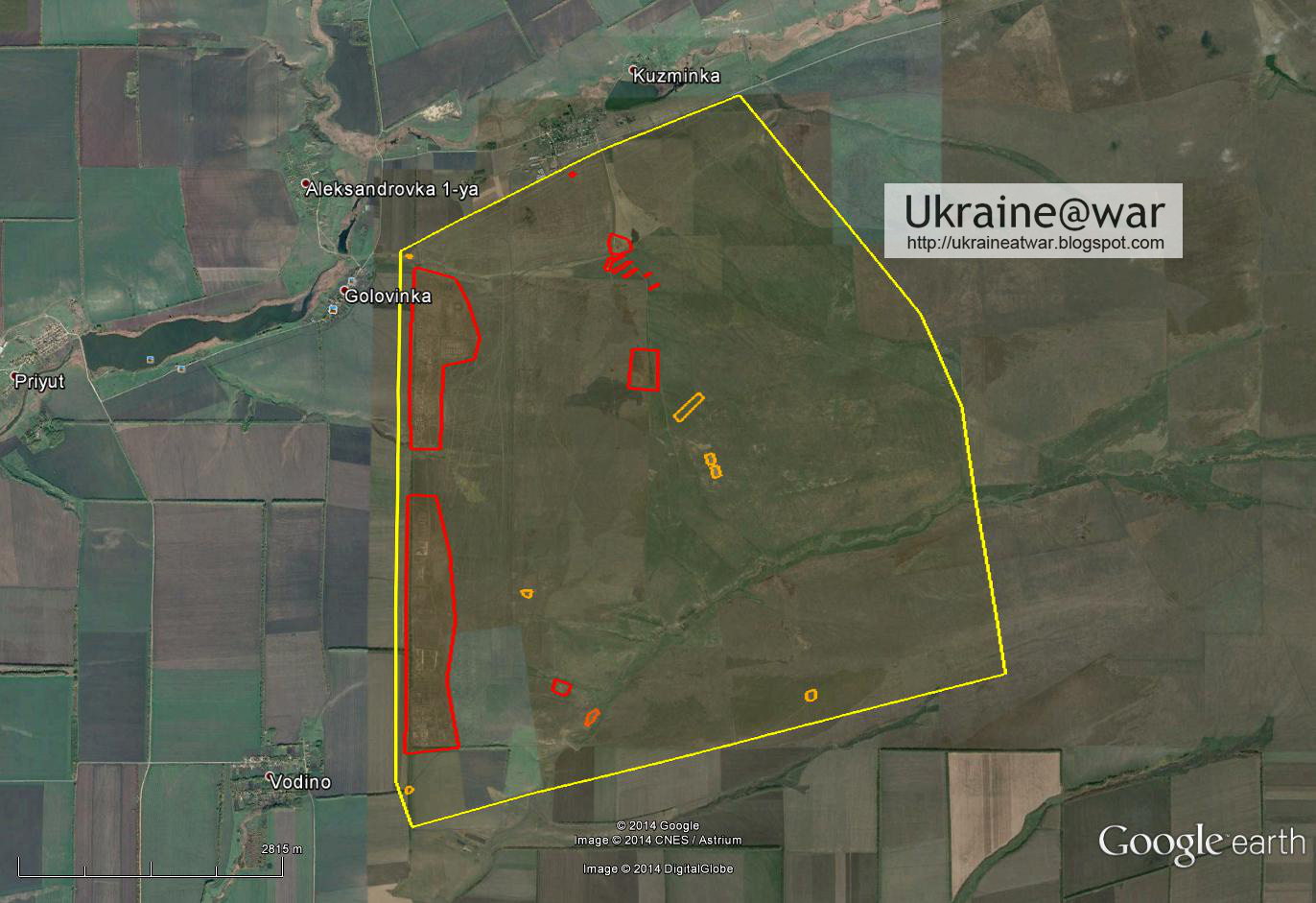
The camp, which is visible on Google Earth, has been home to huge numbers of military vehicles, as demonstrated by both the tracks seen on satellite images and dozens of photos uploaded to VKontakte by Russian soldiers.
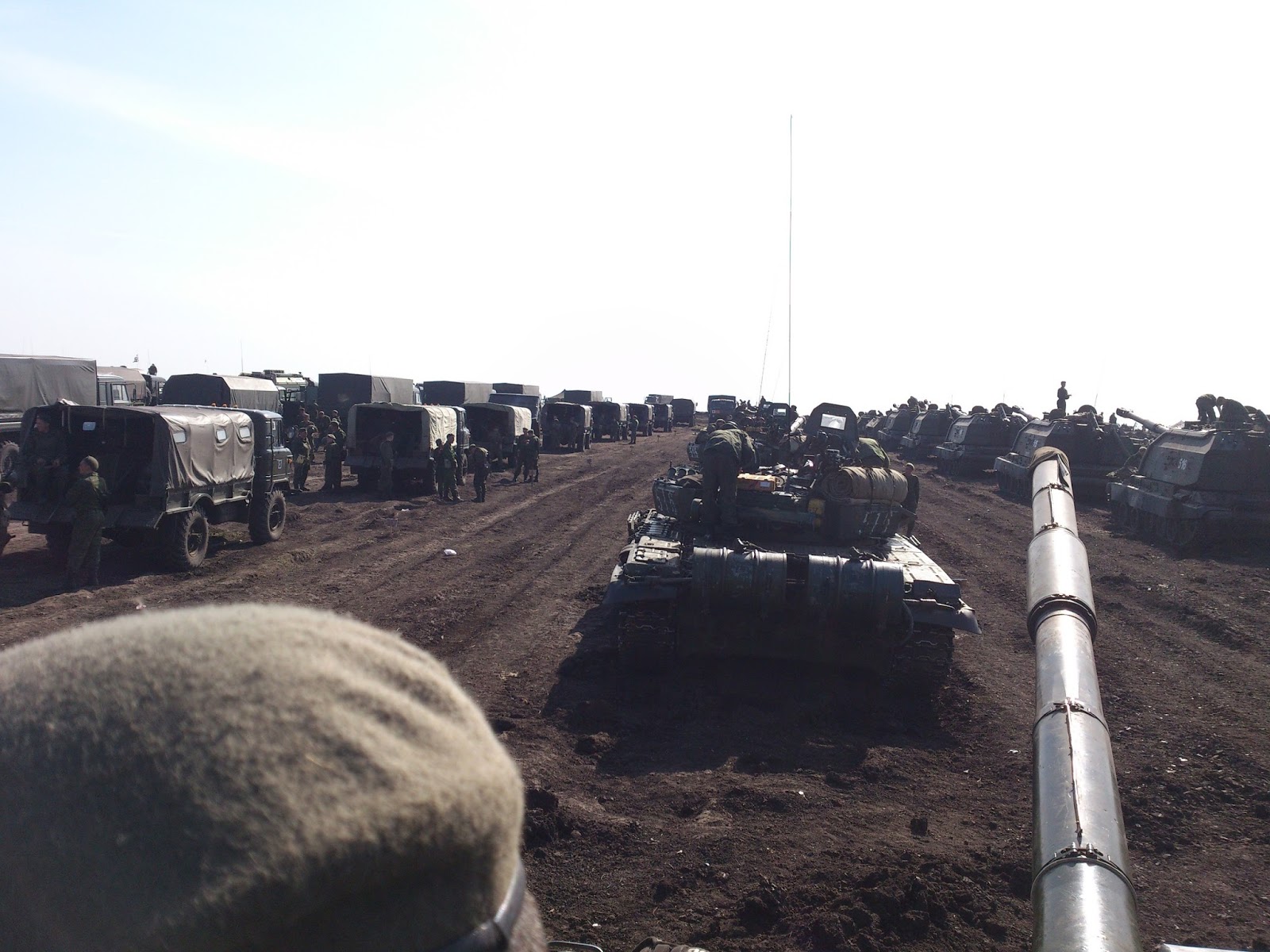
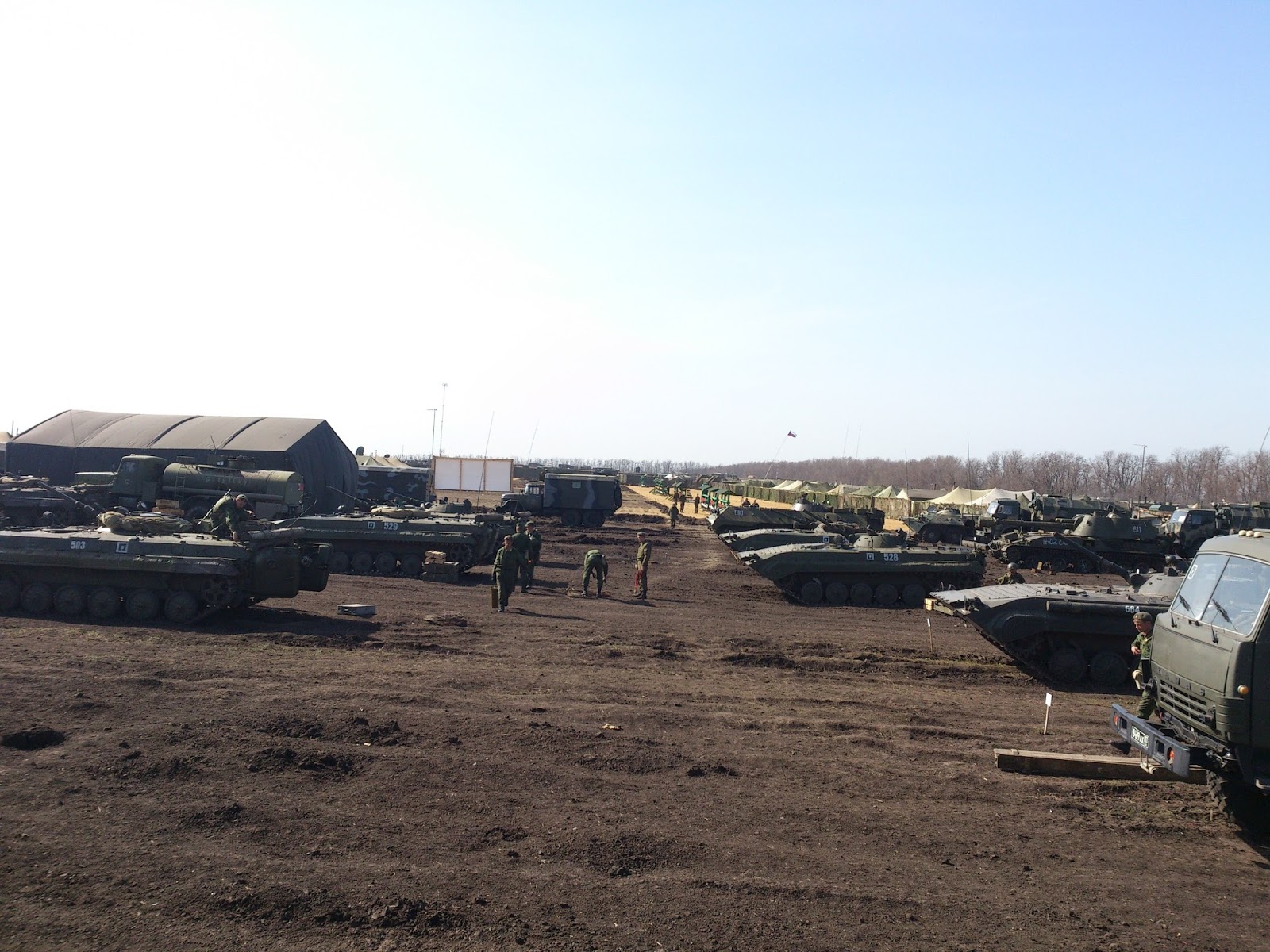

At the time, The Interpreter analysed evidence that suggested that at least some, if not all of the forces photographed at the camp in the summer of 2014 had been deployed to Ukraine in the large-scale Russian military intervention in August that year.
Furthermore, at the beginning of March Novaya Gazeta reported that Dorzhi Batomunkuev, a Russian tank gunner who was severely burned during a battle near Debaltsevo, had told their reporter Yelena Kostyuchenko that, prior to being sent into Ukraine in February, his unit, the 5th tank brigade from Ulan-Ude, were deployed to the Kuzminka camp.
From our report on Batomunkuev’s story:
The troops were then sent onto a military camp or polygon, which Batomunkuev says was in Kuzminka, “where there were many such camps” set up.
Batomunkuev describes a regular flow of arrivals and departures.
“We all spent the night in the barracks. Before us there had been spetsnaz guys from Khabarovsk, from various towns, purely from the east. One by one, you understand? Every day. Our guys went 5th, the 25th or 27th of October.”
Batomunkuev told Kostychenko that the Kantemirovskaya brigade from the Moscow area had arrived at the camp after his unit departed.
Batomunkuev’s battalion spent three months training in the Kuzminsky camp, just as had been planned. As the end of their three-month deployment approached, their superiors told them that they would soon return to Ulan-Ude. There was no mention of heading to Ukraine from Colonel General Sergei Surovikin, the commander of the Russian Eastern Military District, who greeted Batomunkuev’s tank company at the camp before the end of the year.
With the Kantemirovskaya troops already arriving, Batomunkuev’s unit was told they would be heading home by rail and plane from Rostov to Ulan-Ude.
However on February 8, with the battle to encircle Debaltsevo approaching its climax, they were given the order to man their tanks and move out.
On leaving the camp, they were told to hand over mobile phones and documentation. It appears the Russian military is attempting to clamp down on potentially revealing photos and reports appearing on social media, or for bodies to be found with identifiable documents.
After waiting in the woods for a while, they received the order to move west. Batomunkuev says that, while they all knew what was happening, he didn’t realise that he was in Ukraine itself until reaching Donetsk.
— Pierre Vaux